- The Pomodoro technique was created by Francesco Cirillo, an Italian programmer, who famously used his tomato-shaped kitchen timer for better time management.
- While the scientific studies conducted on the efficacy of the Pomodoro method have been small-scale, they have revealed some conjectural benefits.
- Follow the seven steps laid out in this article to start using the Pomodoro method today.
In our interview with Dr. Barbara Oakley, we asked the world-renowned professor and learning expert to highlight the most effective study methods for students. One of her favorite techniques turned out to be the Pomodoro study method.
She put it like this:
“When I find that I am goofing around online or not focusing on what needs to get done, I’ll use this technique [the Pomodoro method] to focus myself and just begin working.”
And Dr. Oakley is not alone in this. Millions of other educators, students, and knowledge workers worldwide have adopted the Pomodoro method since its conception in 1987.
While it’s a method that is almost always discussed in the context of knowledge workers and office productivity, in this guide, however, I’ll focus on using the Pomodoro method as a student.
Here’s what you’ll learn:
The Pomodoro Study Method
What is the Pomodoro study method?
The Pomodoro study method is a time management and productivity technique first conceptualized by Francesco Cirillo, a university student at the time, in 1987. The method involves setting up a timer for 25 minutes and using that time for focused work until the timer rings: a Pomodoro session.
The method was initially designed for studying. After all, in September 1987, when Francesco Cirillo first tested the Pomodoro study technique in Italy, he was using it to study for an upcoming university exam. More specifically, he was using the method to finish a chapter of a sociology book.
Nowadays, however, Cirillo’s Pomodoro technique is widely used in all walks of life. Besides students, any and all knowledge workers, corporate CEOs, professors, writers, and researchers rely on the Pomodoro method to overcome distractions and reach their goals. The method has also found widespread adoption in the agile development industry.
It appears that literally anyone and everyone has adopted the Pomodoro method. That includes me – I use the Pomodoro method on a daily basis as a student, writer, blogger – you name it. If it needs concentration, I take out the Pomodoro.
Where can you find a Pomodoro timer?
To start using the Pomodoro study method, you’ll need a Pomodoro timer. This timer is necessary to keep track of your 25-minute Pomodoro sessions, and there is a wide range of free and paid options available:
Physical kitchen timer. A physical Pomodoro timer (either a traditional wind-up kitchen timer or a more modern variant) can often be the most effective solution if studying at home. However, I have found digital alternatives to suit me better. Partly because I don’t always have the option to work or study alone, and using a physical ticking timer irritates those around me. Especially if you like studying in libraries or cafes as I do. Worst of all is when the timer rings – while I enjoy the sound of a finished Pomodoro, I can’t say the same for my desk neighbor.

RescueTime. Personally, I have been using RescueTime for the last year or so. While its timer function is the same as any other, I like that it has a distraction-blocking feature that you can use to block out any distractions, such as YouTube, Twitter, or Facebook. Multi-device blocking features have been found to lead to lower levels of stress and, thus, more effective Pomodoros. Having the ability to hard-block any distractions can be very helpful – especially if you find yourself being distracted by specific websites.

Marinara: Pomodoro Assistant Chrome Extension. The Marinara: Pomodoro Assistant is a free-to-use Google Chrome Extension that serves its purpose well. You can pin the extension to your taskbar and have a constant overview of the time left on your Pomodoro (for better or worse). The extension also allows you to change the focus times, sounds, break times, and more. It’s relatively basic in its functionality, but basic is really all you need.
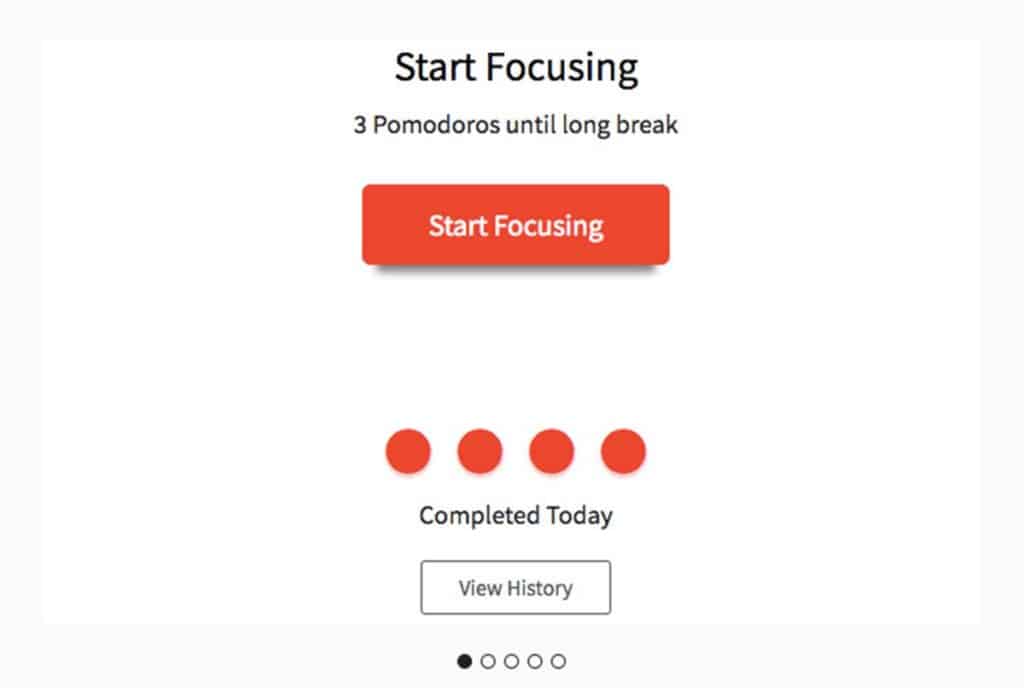
TomatoTimer. The Tomato Timer is another simple and basic free Pomodoro timer that does its job. The only downside is that you always need to have it opened on a tab for it to work, and it will not function without an Internet connection. From the available free options, I prefer the Marinara extension.
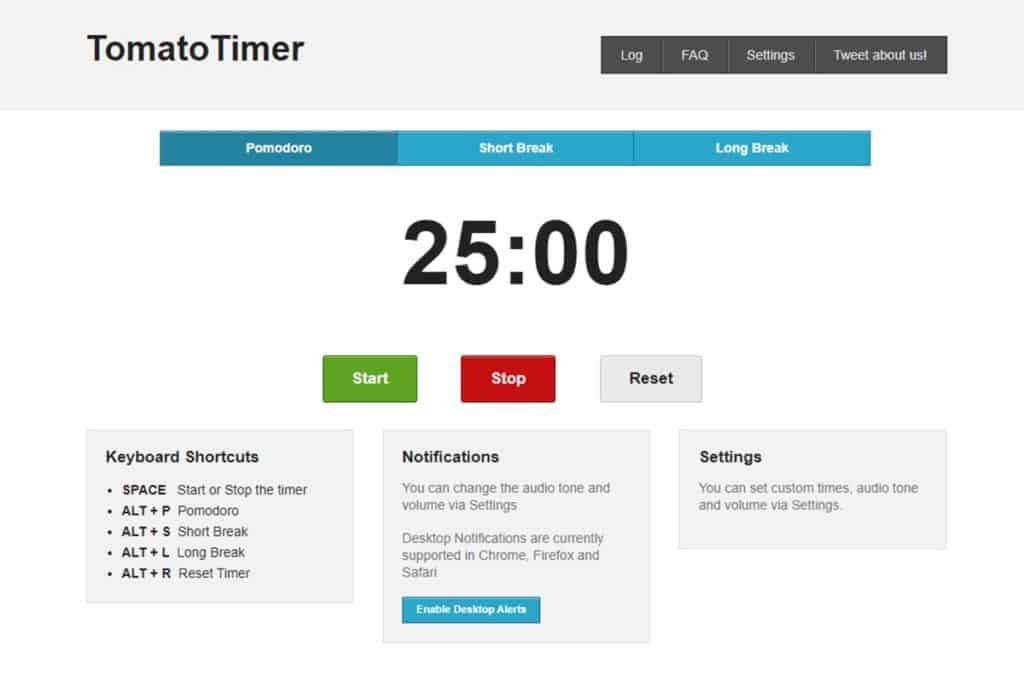
Ultimately, though, your success will not depend on your timer. Pick whatever timer is easiest for you to implement into your study routine and stick with it. What is more important than the timer is where you study – your study space. But, creating an effective study space is an entirely different beast outside of the scope of this article.
What makes the Pomodoro technique effective for studying?
Despite the massive popularity of the Pomodoro study method, surprisingly little research has been conducted on its effectiveness. And the studies that have been done on it have been small in scale. Thus, the benefits of the Pomodoro study method tend to be conjectural.
While there are many commonly believed benefits of the Pomodoro study method, the two that appear to have the most merit are the following:
- Short mental breaks help you stay focused and avoid loss of control over your thoughts.
- Tracking your daily tasks improves self-awareness and productivity.
The Pomodoro study method does take advantage of both of these benefits. And from my personal anecdotal evidence, I can also attest to the effectiveness of the Pomodoro study method. Without a doubt, using the technique has led me to increased productivity. And I know many knowledge workers, students, and professors who would echo the same statement.
However, I do think that the effectiveness of the Pomodoro study method deserves further scientific research.
How to use the Pomodoro study method
In this step-by-step guide, I’ll be covering the method taught by Francesco Cirillo himself in his book. However, I have slightly adapted it for studying as his book largely focuses on work productivity.
Here’s how you use the Pomodoro study method:
Plan your daily tasks in the To-do Today Sheet
At the beginning of your study session, plan all the tasks you want to accomplish, prioritize them, and write them down in your “To-do Today Sheet.” This sheet will serve as the central point for your study session, where you’ll see how much time you spend on each activity and what comes next.
To plan your daily tasks and To-do Today list, you will need to establish the following:
- What types of tasks do you need to complete the study session?
- In what order should these tasks be completed?
- How many 25-minute Pomodoro sessions does each task need to be completed?
In the beginning, your task planning will be way off. After all, most students are not used to listing all their daily tasks, ordering them, and estimating their time requirements. It’s a skill that needs development, but in time, your ability to estimate will improve.
As a rule of thumb, Francesco Cirillo recommends breaking tasks down if they require more than five to seven 25-minute Pomodoro sessions.
As an example, here’s what a To-do Today Sheet for a study session on “Parasomnias” might look like:

The lines in the center of the page are your daily tasks, and each task must begin from a separate line. Don’t forget to leave enough room for the two columns on the left and right sides of the tasks. These will be needed in the upcoming steps. Curious about the note-taking tasks listed here? Check out my guides to the Cornell note-taking method and charting note-taking method.
Now that we have our study session mapped out let’s get to work.
Set the Pomodoro timer for 25 minutes
Before you start your first Pomodoro session, make sure to eliminate any and all possible distractions. Interruptions are the nemesis of a good Pomodoro session, so make sure to avoid them as much as you can. Your phone should be turned off (or at least on silent mode and hidden), and all popups and notifications should be disabled.
Now, to start your first Pomodoro session, choose your task, set your timer to 25 minutes, and start the timer. This is when the studying begins.
Start working on your first task
Now it’s time to start focusing on the task at hand. Ideally, you will know exactly what you need to do, and you can simply execute your strategy. This is why establishing simple and actionable daily tasks is important. You should not be second doubting your task choice at this stage – you should be focused fully on completing the task.
Focusing for 25 minutes may seem like nothing, but it can be surprisingly difficult. A Pomodoro session requires absolute focus, and having to focus all your energy on a single task can be rather difficult. Especially if you’re not used to it.
During those first Pomodoro sessions, you’ll likely have those moments when you look at your timer thinking, “19 more minutes? No way!”. If you find yourself slipping away from the task and wanting a break, take a deep breath first. Then, collect your thoughts and continue with the task. The feeling of a completed Pomodoro, in the end, will be worth all the effort you put in.
Finish working on the task when the timer rings
Once the timer rings, it’s time to stop. Write a cross into the appropriate line in the To-do Today Sheet to mark the end of a session and you’re all done.
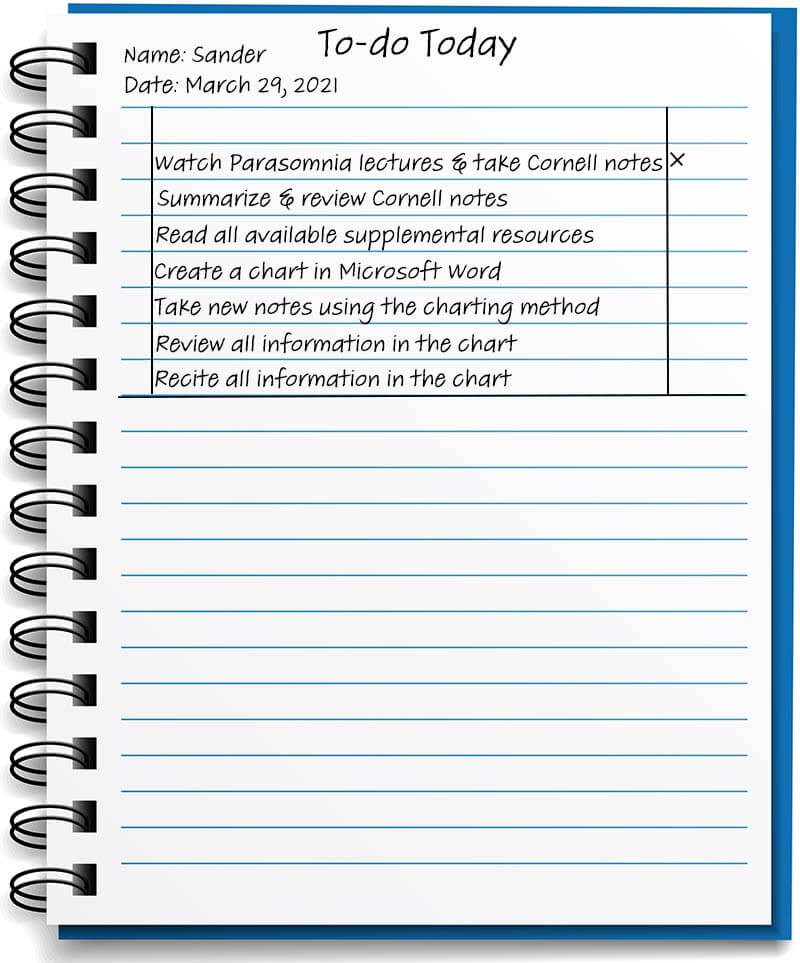
If you’re in a good workflow, you might be tempted to continue studying after the timer rings. However, the whole point of the Pomodoro study method is to take advantage of small but frequent breaks. If you find this to be counterproductive, I would recommend that you look into the Flowtime method, which builds on Pomodoro.
In the beginning, you’ll likely find it difficult to get used to these 25-minute chunks of productivity. However, if you keep using the method, you’ll soon find that your brain slowly starts getting used to this routine.
When you reach that point, your brain will be so used to studying in sessions of 25 minutes that even without setting a timer, you’ll feel when you’ve studied for 25 minutes. By then, you’ll have an internal Pomodoro timer, so to speak.
Write down any interruptions on the To-do Today Sheet
If you were interrupted by something during your session, you’d want to write that interruption down and continue working on the task as soon as possible. It’s only natural that different distractions will pop up while you’re trying to study, but you can’t let these interruptions break your 25-minute Pomodoros.
Interruptions, together with any extra details such as deadlines, are written under the tasks in the To-do Today Sheet, like so:
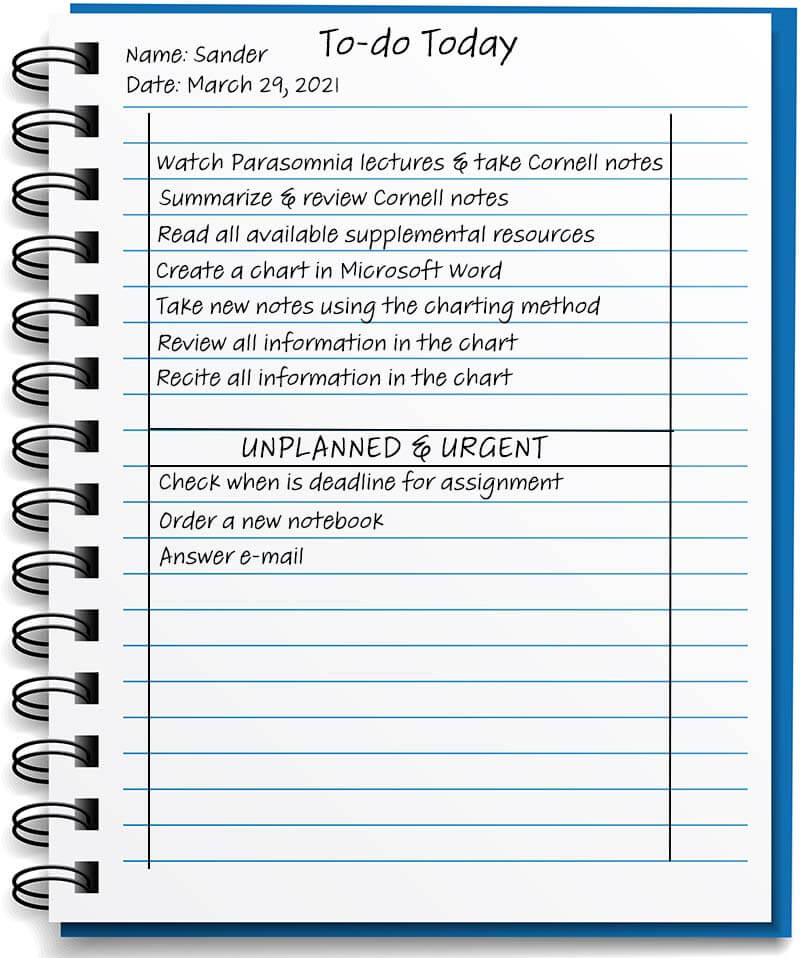
Sooner or later, you will be interrupted, and it’s important to quickly jot those interruptions down and continue with the task. Then, once you’re finished with your Pomodoro session, you can start evaluating the interruption. If it’s something urgent, you can dedicate the next Pomodoro session on it.
Remember that Pomodoros are indivisible. You can’t finish a Pomodoro at 22 minutes and call it “finished”. The length of a Pomodoro never changes and if you stop halfway then the session is void and null. If that happens, try to stay positive and to make sure that the next Pomodoro will go better than the previous.
Mastering the Pomodoro study method is all about cutting down on interruptions and not letting those interruptions break your sessions.
Take a 5-minute break
During this break, try not to do any mentally straining tasks. Avoid thinking about the topic you’re studying, and try to get your mind out of the topic as much as possible.
Switching your mind off of what you’re studying may seem counterintuitive if you’re in a good workflow. However, it’s important to get some time for rest. Otherwise, you will not feel ready for the new Pomodoro, and you’ll start experiencing burnout after only a few Pomodoros.
Instead of thinking about your study topic during the break, consider the following:
- Standing up and walking around.
- Getting a new glass of water.
- Doing breathing exercises.
- Stretching your muscles.
- Doing a short meditation session.
Disconnecting yourself from the lecture topic for this brief period of time will give your mind a chance to relax before winding up the Pomodoro timer once more.
Once the 5 minutes is up, return to your study space and continue your study session with the next 25-minute Pomodoro. You’ll be repeating this cycle until you finish 4 Pomodoro sessions in a row.
Take a 15-to-30-minute break after 4 Pomodoro sessions
Once you have completed four 25-minute Pomodoro sessions together with four 5-minute breaks (for a total of 2 hours), you will take an extended break. In his book, Francesco Cirillo recommends a length of 15 to 30 minutes for this break.
At this point, your To-do Today Sheet will look something like this:
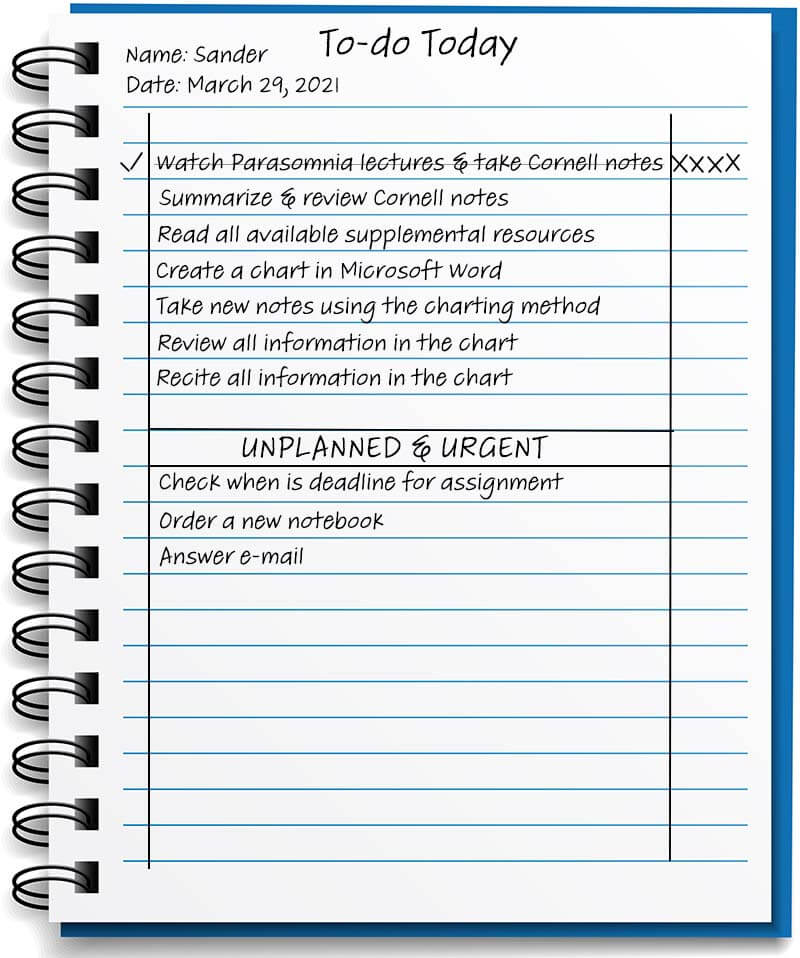
Consider using the extended break to:
- Prepare yourself something light to eat.
- Walk outside if the weather allows it.
- Organize your study desk.
- Do breathing exercises, yoga, or meditation.
Personally, I prefer not to count the minutes for this break. If it’s time to eat, I will prepare myself something to eat, and otherwise, I’ll often walk outside during this time if the weather allows it. Meditation can also work wonders, but I’ll typically only do that once per day at most.
Once again, though, try to avoid thinking about your study topic during this extended break. Your mind needs rest to function properly, and this is your chance to do your mind a favor by letting it rest for a moment.
After this extended break, it’s time to return to step #2 and set up another Pomodoro session. You’ll rinse and repeat this until you’re finished with your study session.
That’s it – this was the Pomodoro study method in a nutshell. I’ll admit I skipped over some details, such as Inventory Sheets and the Activity Inventory, but I’ll be covering them in future articles. For now, I hope you learned something from this article and I wish you good luck on your Pomodoro sessions!


